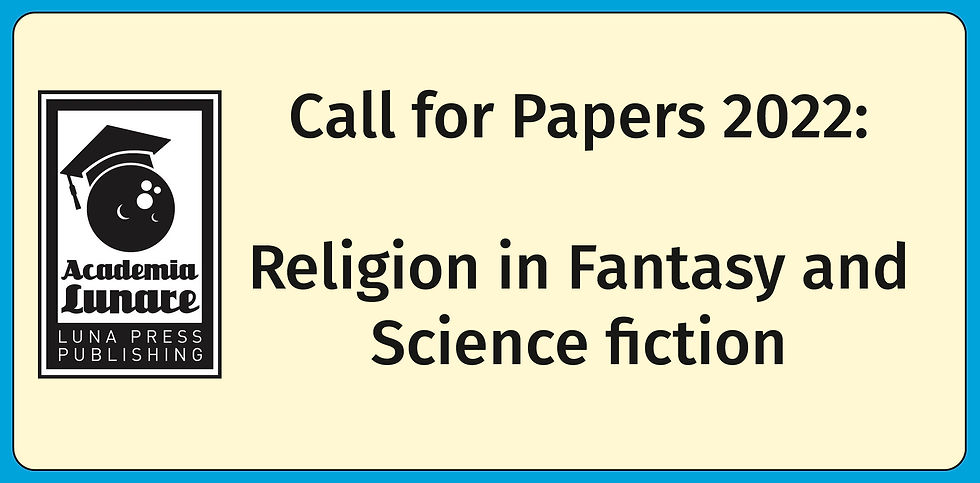The Last Prince of Cardolan: Memory and mediation in the mortuary archaeology of Middle-earth
- Francesca T Barbini
- May 23, 2022
- 3 min read

Luna's sixth Call for Papers, Not the Fellowship. Dragons Welcome! is now in pre-order and will be released on Tuesday 14th of June. Artwork, by Jay Johnstone. Here is a chance to discover the 11 brilliant papers you will find in the book, in reverse order of appearance.
Today, we would like to introduce you to Scott Chaussée, presenting the paper: "The Last Prince of Cardolan: Memory and mediation in the mortuary archaeology of Middle-earth"
Abstract:
This paper analyses the character of the Barrow-wights, their setting, their historical context (both Middle-Earth and contemporary Earth), and how the episode in The Lord of the Rings contributes to the narrative’s themes of memory, mediation, and legitimacy. The materiality and the landscape of the Barrow-wights are discussed as a culmination of archaeological, historical, and mythic influences.
Frodo, Sam, Merry, and Pippin encounter the Barrow-wights after they leave the house of Tom Bombadil. The Barrow-wights are corporeal undead that reside in a sub-region densely populated with burial mounds – the Barrow-downs, east of the Old Forest and south-west of Bree, in Eriador. After becoming trapped in the tomb widely interpreted as that of the last prince of the Arnorian kingdom, Cardolan, the hobbits fall under the spell of a Barrow-wight and are in mortal danger. Tom Bombadil saves the fellowship, and the adventure continued.
This paper argues that the barrows and the Barrow-wights, rather than simply clever pieces of world-building, are potent mnemonic devices reinforcing the power of memory, the danger of its loss, and can be viewed in contrast to the active acts of remembrance performed by the Rohirrim at the tombs of their kings outside Edoras. First, the geographic and historical context of the character and its setting are introduced, using the available additional primary and secondary sources of the history of Middle-earth. Second, the encounter of the hobbits in the Great Barrow in the story’s text is introduced. Third, the power of the ‘special dead’ in the early medieval mind is discussed. Fourth, the archaeology of mortuary architecture in Britain is presented, with particular reference to case studies that may have influenced the imagination of the Barrow-downs and its inhabitants. Finally, Tolkien’s influences from archaeology and history are combined in a discussion regarding the power of memory, the changing role of these monuments from sacred to profane and how the episode of the Barrow-downs affected the outcome of the War of the Ring.
About Scott Chaussée:
Scott Chaussée is an archaeologist who specialises in understanding communities and the power of the landscape in shaping people’s beliefs and actions. He is completing his PhD in Landscape Archaeology at University College London and is active in teaching, research, and professional practice. His research particularly explores how early medieval communities situated themselves within the landscape and utilised the relict landscape in constructing their social and territorial identities. He teaches archaeology courses in the lifelong learning department at Aberystwyth University in Wales, hoping to inspire the next generation of archaeologist researchers.
When not writing his own dark fantasy and horror fiction, Scott most likely is re-reading The Lord of the Rings, as he has done annually for the last 20 years. Middle-earth is another home for him, and the richness of Tolkien’s world, with its linguistic, mythological, material and landscape influences has been a source of wonder and inspiration. The detail of its construction is so clear and consistent that it allows for an archaeological interpretation of its material culture, as one could with any past society.
Scott is originally from Lawrence, Kansas in the USA but has lived in the United Kingdom for the last 11 years. He lives with his beautiful wife, Anna, in the leafy city of Winchester in the heart of southern England.
Not the Fellowship. Dragons Welcome!
#Callforpapers2021 #AcademiaLunare #NotTheFellowshipDragonsWelcome #FrancescaTBarbini #ScottChaussée #Cardolan #Tolkien #TolkienScholarship #LastPrinceOfCardolan






Comments